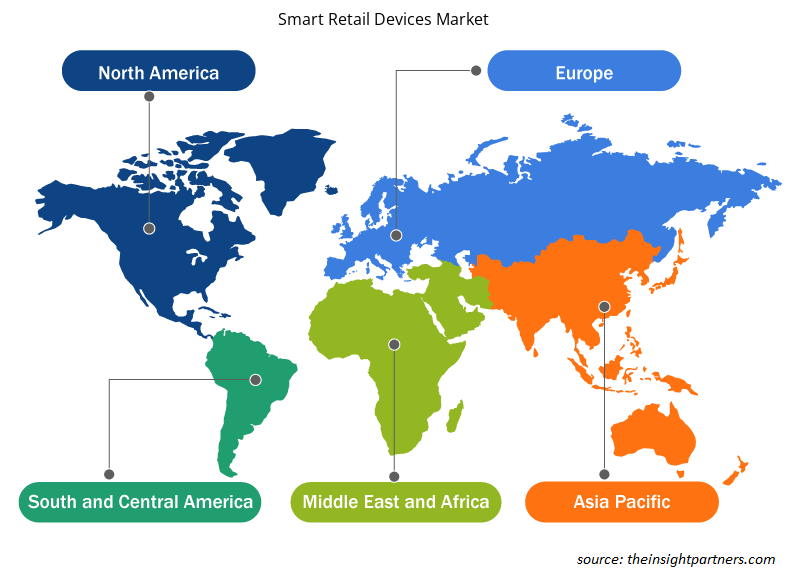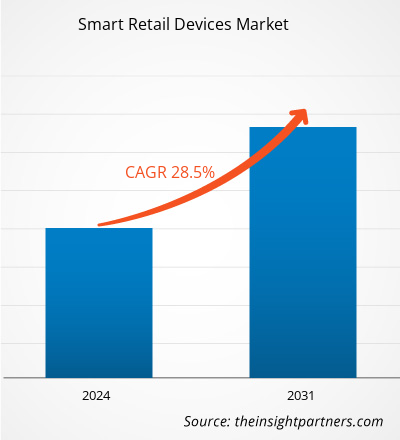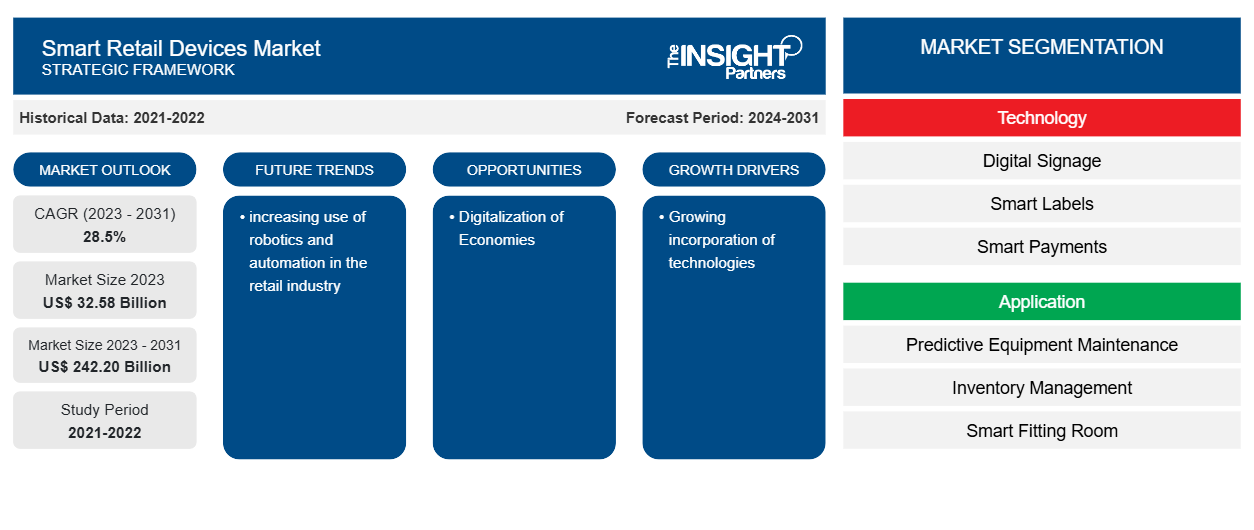智能零售设备市场规模预计将从 2023 年的 325.8 亿美元增长到 2031 年的 2422 亿美元;预计从 2024 年到 2031 年的复合年增长率为 28.5%。零售行业中机器人和自动化的使用日益增多,这可能仍然是智能零售设备市场的一个关键趋势。
智能零售设备市场分析
零售行业对大数据分析和物联网 (IoT) 的日益采用以及消费者购买力的激增是智能零售设备市场的主要驱动因素。
智能零售设备市场概览
智能零售是利用技术和数据来改善客户购物体验和公司运营。这些技术使组织能够改善客户体验,简化流程并获得有关消费者行为的重要见解。这些联网设备使用户可以轻松访问量身定制的信息和服务,而语音识别和触摸板集成等先进功能使购物变得轻而易举,虚拟助手可以引导消费者选择合适的商品,浏览有趣的交易,进行购买,甚至在社交媒体上捕捉和分享体验。
定制此报告以满足您的需求
您可以免费定制任何报告,包括本报告的部分内容、国家级分析、Excel 数据包,以及为初创企业和大学提供优惠和折扣
- 获取此报告的关键市场趋势。这个免费样品将包括数据分析,从市场趋势到估计和预测。
智能零售设备市场驱动因素和机遇
日益融入技术以利于市场
人工智能 (AI)、虚拟现实 (VR)、增强现实 (AR) 和物联网 (IoT) 等技术的集成在零售行业得到越来越多地应用,以增强购物体验、改善库存管理并简化商店运营。物联网 (IoT) 是智能零售环境中的重要组成部分,因为它将小工具连接到互联网并提供有关客户行为、商店运营和库存管理的重要数据。物联网设备(如传感器和信标)使商家能够收集有关库存水平、客户流量和商店资产的实时数据,从而使他们能够做出更明智的决策并优化运营。
经济数字化
数字化的使用为商店带来了多种好处,包括吸引新消费者和降低运营成本。此外,数字化能够极大地激励零售员工。因此,零售商的收入可能会增加。值得注意的是,非店内购物在 2020 年实现了显着增长。在线零售店可能会从技术改进、连接增加、新型传感器的引入以及无缝通信解决方案的可用性中受益匪浅,从而在整个预测期内为市场增长做出重大贡献。
智能零售设备市场报告细分分析
有助于得出智能零售设备市场分析的关键部分是技术和应用。
- 根据技术,市场分为数字标牌、智能标签、智能支付、智能购物车等。数字标牌领域在 2023 年占据了更大的市场份额。
- 从应用方面来看,市场分为预测性设备维护、库存管理、智能试衣间、人流量监控等。库存管理部分在 2023 年占据了更大的市场份额。
智能零售设备市场份额(按地区)分析
智能零售设备市场报告的地理范围主要分为五个地区:北美、亚太地区、欧洲、中东和非洲以及南美/南美和中美洲。2023 年,北美主导了智能零售设备市场。预计在整个预测时间范围内,该地区将成为市场上最大的收入来源。对高端产品和奢侈品的需求日益增加,再加上客户偏好向更方便、更省时的零售体验的动态转变,是推动这一趋势的主要因素。此外,数字技术在各个领域的广泛融合正在重塑美国经济。疫情的后果大大加速了零售行业企业的数字化转型,超出了之前的预期。
智能零售设备市场区域洞察
Insight Partners 的分析师已详尽解释了预测期内影响智能零售设备市场的区域趋势和因素。本节还讨论了北美、欧洲、亚太地区、中东和非洲以及南美和中美洲的智能零售设备市场细分和地理位置。

- 获取智能零售设备市场的区域特定数据
智能零售设备市场报告范围
| 报告属性 | 细节 |
|---|---|
| 2023 年的市场规模 | 325.8亿美元 |
| 2031 年市场规模 | 2422亿美元 |
| 全球复合年增长率(2023 - 2031) | 28.5% |
| 史料 | 2021-2022 |
| 预测期 | 2024-2031 |
| 涵盖的领域 | 按技术分类
|
| 覆盖地区和国家 | 北美
|
| 市场领导者和主要公司简介 |
|
智能零售设备市场参与者密度:了解其对业务动态的影响
智能零售设备市场正在快速增长,这得益于终端用户需求的不断增长,而这些需求又源于消费者偏好的不断变化、技术进步以及对产品优势的认识不断提高等因素。随着需求的增加,企业正在扩大其产品范围,进行创新以满足消费者的需求,并利用新兴趋势,从而进一步推动市场增长。
市场参与者密度是指在特定市场或行业内运营的企业或公司的分布情况。它表明在给定市场空间中,相对于其规模或总市场价值,有多少竞争对手(市场参与者)存在。
在智能零售设备市场运营的主要公司有:
- 英特尔公司
- 三星集团
- NVIDIA 公司
- LG 电子
- 斑马技术公司
- 卡珀公司
免责声明:上面列出的公司没有按照任何特定顺序排列。

- 了解智能零售设备市场顶级关键参与者概况
智能零售设备市场新闻和最新发展
智能零售设备市场通过收集一手和二手研究后的定性和定量数据进行评估,其中包括重要的公司出版物、协会数据和数据库。以下是市场发展情况的列表:
- 2023 年 6 月,英特尔与 Vericast 联手开发、实施和评估了先进的可编程数字店内零售媒体网络。该创新系统利用 Vericast 先进的定位技术和英特尔强大的 Edge 软件平台,提供与客户购物旅程相符的个性化广告和产品详细信息。此次合作是我们更广泛计划的重要组成部分,旨在彻底改变零售业并利用实体店的数字化转型,这被广泛认为是广告行业的下一个主要趋势。
(来源:英特尔,新闻稿,2023 年)
- 2023 年 11 月,Panasonic Connect Europe 推出了一款新的 AI 解决方案,旨在通过生成式 AI 助手在顾客购物时为他们提供个性化广告,从而改变零售业。这种创新的解决方案使商店能够自动监控购物者的人口统计数据,并将这些信息与购买偏好、天气数据和当地活动相结合,以即时个性化店内展示的广告。松下与领先的数据和 AI 专家 ADEAL Systems 合作,将其 AI 驱动的个人购物助手 CUSAAS(客户细分即服务)与最先进的零售技术摄像头和显示解决方案相结合,创造增强的购物体验。
(来源:松下,新闻稿,2023 年)
智能零售设备市场报告覆盖范围和交付成果
“智能零售设备市场规模和预测(2021-2031)”报告对以下领域进行了详细的市场分析:
- 范围内所有主要细分市场的全球、区域和国家层面的市场规模和预测
- 市场动态,如驱动因素、限制因素和关键机遇
- 未来的主要趋势
- 详细的 PEST/波特五力分析和 SWOT 分析
- 全球和区域市场分析涵盖关键市场趋势、主要参与者、法规和最新市场发展
- 行业格局和竞争分析,涵盖市场集中度、热点图分析、知名参与者和最新发展
- 详细的公司简介
- 历史分析(2 年)、基准年、预测(7 年)及复合年增长率
- PEST和SWOT分析
- 市场规模、价值/数量 - 全球、区域、国家
- 行业和竞争格局
- Excel 数据集
近期报告
客户评价
购买理由
- 明智的决策
- 了解市场动态
- 竞争分析
- 客户洞察
- 市场预测
- 风险规避
- 战略规划
- 投资论证
- 识别新兴市场
- 优化营销策略
- 提升运营效率
- 顺应监管趋势





















 获取免费样品 - 智能零售设备市场
获取免费样品 - 智能零售设备市场